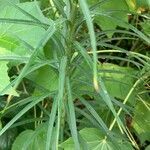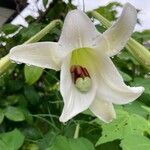Bulb subglobose or broadly ellipsoid, 2--4 cm in diam.; scales white or tinged yellow, lanceolate-ovate to lanceolate. Stem sometimes tinged purple-red, 20--55 cm, smooth or papillose. Leaves scattered, linear or narrowly lanceolate, 2.5--15 cm × 4--13 mm. Flowers solitary or sometimes several in a subumbel, fragrant, funnelform, with a slender tube gradually expanding toward apex. Tepals white, tinged purple-red abaxially; outer ones oblanceolate, 11.5--14.5 × 2.1--2.3 cm; inner ones spatulate, to 3 cm wide; nectaries green, rarely indistinctly papillose on both surfaces. Filaments ca. 10 cm, with minute protuberances near base. Style ca. 6.5 cm. Capsule 7--9 × ca. 2 cm. Fl. and fr. Jun--Dec.
Perennial herb; bulb scales thickened, lanceolate. Stem annual, erect, slender, usually 0.5–2 m tall, glabrous. Leaves alternate, linear-lanceolate to linear, to 15 cm long, usually 0.5–1 cm wide, smaller towards inflorescence. Flowers terminal, 1–8, horizontal to slightly ascending, fragrant; pedicels 5–15 mm long. Perianth segments oblanceolate, to 15 cm long, white with dull mauve median line. Stamens c. 10 cm long; anthers cylindrical, 8–10 mm long, yellow or yellow-purple. Ovary 3–3.5 cm long; style slender, 7–8 cm long; stigma 3-fid, yellow-white or green-white. Capsule cylindrical, 5–8 cm long. [See also Green (1994: 513).]
A bulb plant. The bulb is almost round and 2-4 cm across. The scales are white or tinged yellow. The stem is 20-55 cm tall. It is sometimes tinged purple-red. The leaves are scattered. They are narrow and sword shaped. The leaf blade is 2.5-15 cm long by 4-13 mm wide. The flowers can occur singly or as several in a group. They have a scent. They are white tinged with purple-red. Each flower can produce hundreds are small seeds.
Stem c. 75 cm × 8 mm, glabrous, Purple below, green above, rooting freely at ground-level and for some distance below. Leaves many, sessile, narrow-linear, c. 13 cm × 3-4 mm, dark green, ± shining. Flowers 1-2-(3), 15-18 cm long, borne horizontally, white inside, tinged purple on outside. Capsule not seen.
Geophyte, up to 2 m high. Leaves alternate, many, linear, up to 160 mm long. Flowers solitary, paired or 3-10 in an umbel, funnelform, white inside, suffused wine-purple outside. Flowers white.


